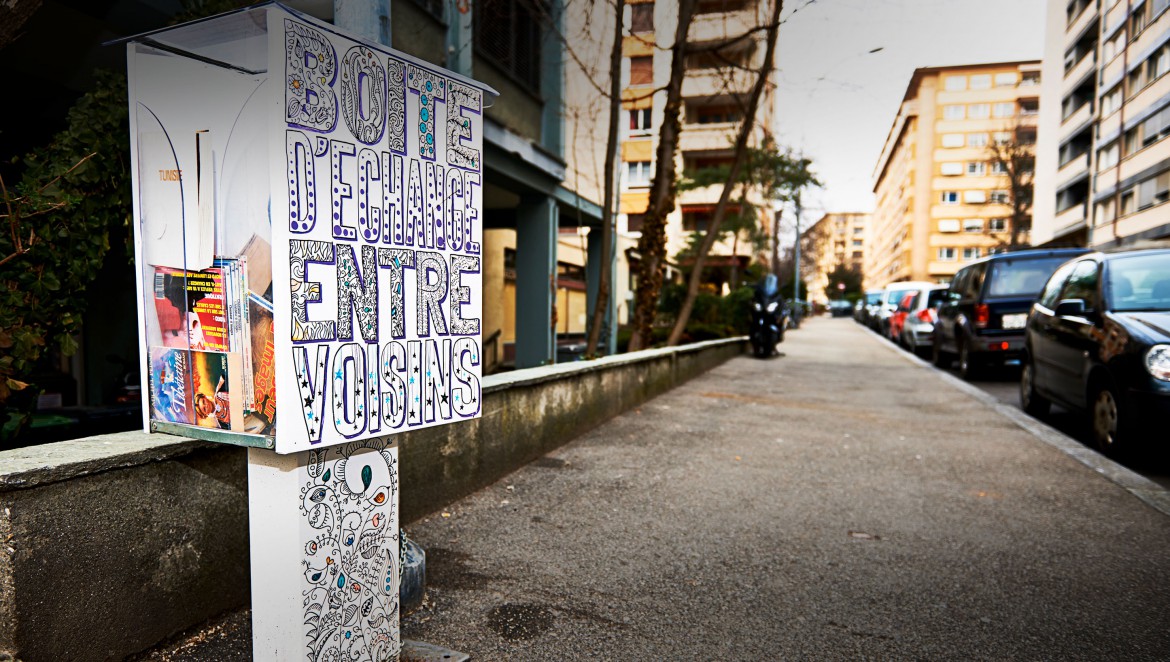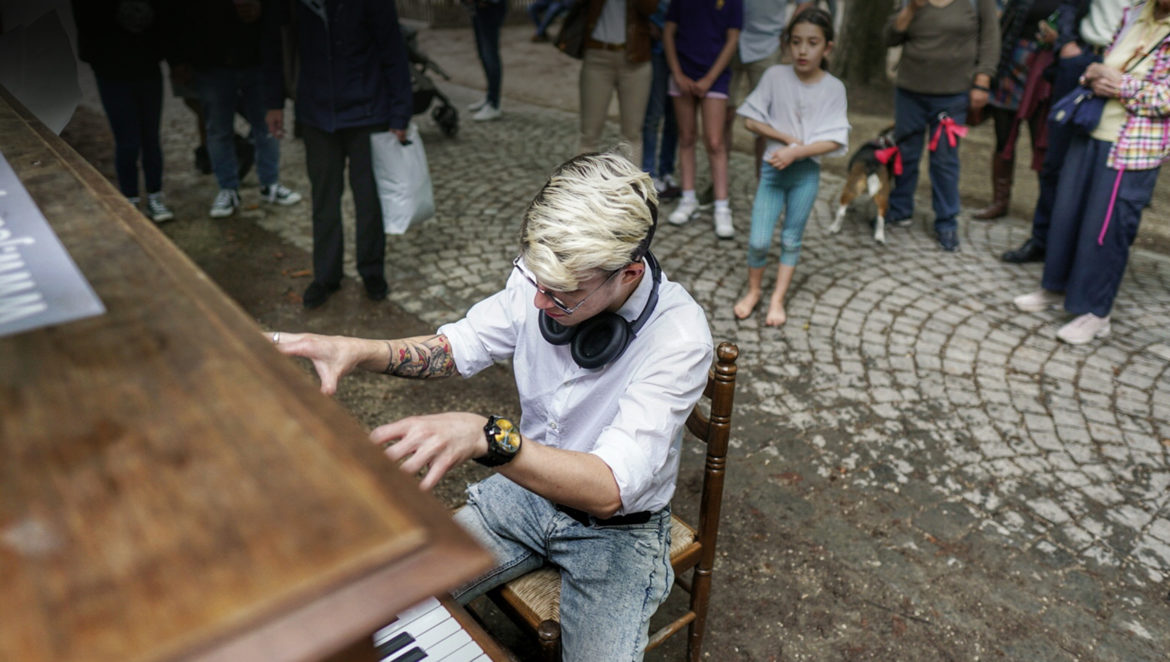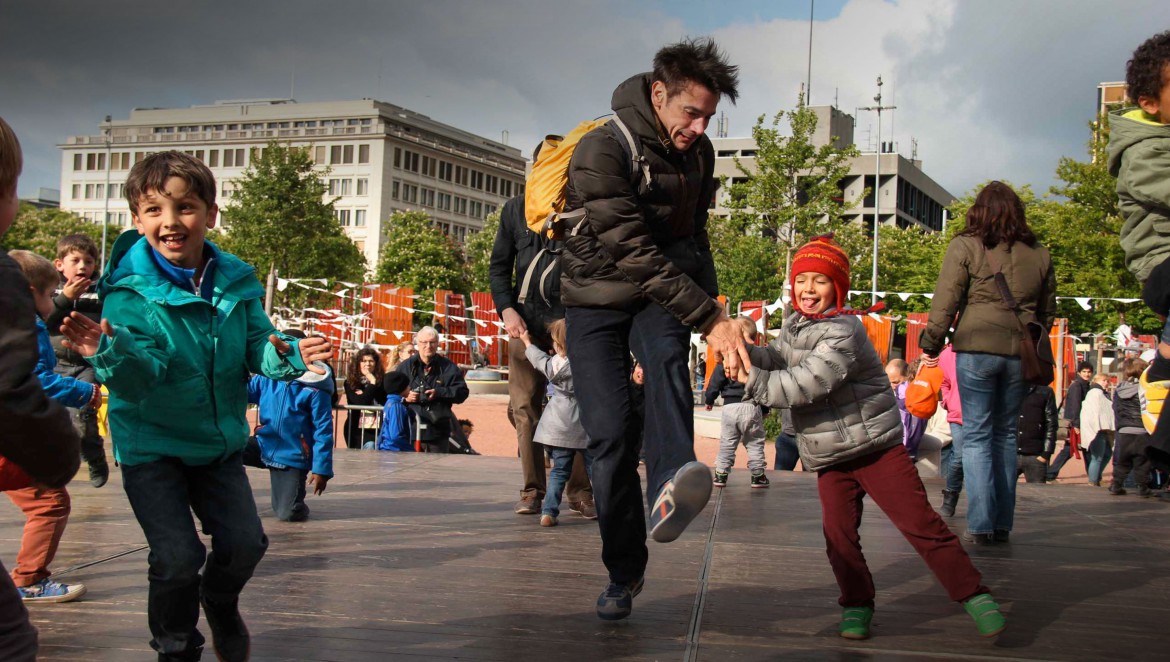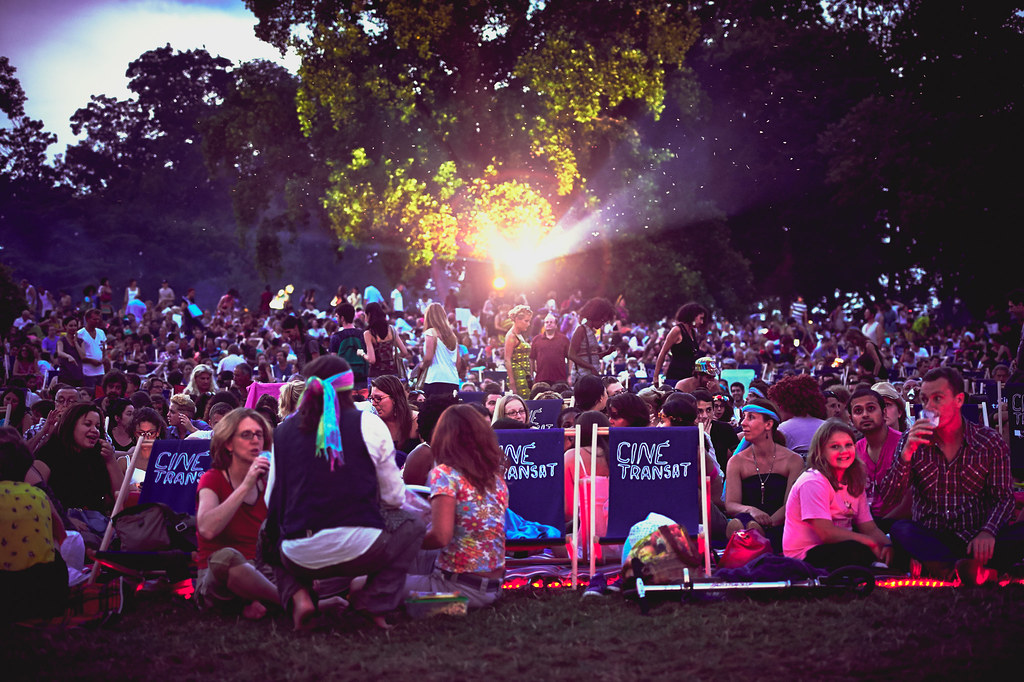“Thanks to you, I love my city—I met lots of people, sang and danced until 4 a.m.” This is the type of feedback that Dan Acher, social artist and founder of Happy City Lab, receives when he is recognized in the streets of Geneva. With his work, he has succeeded in creating moments of sharing and conviviality in European cities and beyond. We met with him to talk about his vision of the city and his relationship with art.
Interview by Clothilde Sauvages, connector at Ouishare
Dan, you studied anthropology and today you are the founder and artistic director of Happy City Lab. Can you tell us about your career, and how the connection of anthropology with artistic creation makes sense in your daily life?
I have traveled a lot from an early age, and what interested me was to see how people live together, what rituals punctuate their lives and what gives meaning to their connected lives. I studied in New Zealand and before I left, I spoke with two friends who read the book “Songlines” for their ethnology course in Switzerland. This book talks about the songs of Australian aborigines, who describe the landscape as they travel across the country. If all these songs are combined, we obtain a precise and exhaustive geographical map of the country. It was a revelation because at the time I did not know that ethnology was an area that could be studied at university. When I arrived in New Zealand, I changed my BCom (trade) course to BA (Arts) and studied anthropology for 3 years. Today, I do not consider myself an anthropologist, but it opened my mind to different ways of living and different representations of the world.
My goal is not the installation in itself but the experience it creates, how the installation creates impact and how people seize the project.
I am sensitive to questions such as: What is the universal nature of certain celebrations, ways of sharing experiences, emotions? How will a project that is conceived for a given place be experienced elsewhere? What interests me deeply is to explore what enables two strangers to meet, share an experience, an emotion, beyond what separates them. How can art and rituals achieve this goal and how can this impact be scaled up across either a community, a neighborhood, a city, or the world?
Do you take a universal approach with your projects, or do they take a specific form depending on where you develop them?
Generally, it is more the universal aspect that prevails. And yet I can’t tell you the number of times I was told “it will never work in my country”. Many French people were convinced, for example, that the exchange boxes intended to encourage exchange between residents of the same district would not work out, because they assumed that there is not the same level of civic education there as in Switzerland. It’s been a success nonetheless. We must be ready to experiment and to examine what happens. Authorities are often surprised by the results and the way people react positively to it.

How would you define the “Happy City Lab”? Is it the process of creating situations?
Indeed, one of the definitions of my work is to create situations. Happy City Lab is a laboratory where we test different projects to see how they fit into society, and the effects and impacts they produce.
You have an approach that combines sociology, art and events through which you remove people from their daily lives.
A strong influence for my work is the “situationist” movement that appeared in the 50s and 60s to push the revolution of daily life. The street and the city became large playgrounds rather than smooth, frictionless geographical spaces. The demonstration of May 1968 in Paris, the book “The society of the spectacle” of Guy Debord, or the Cacophony Society which gave birth to Burning Man in the United States, are emanations of this school of thought which aimed at breaking the routine to be constantly in the present and the extraordinary. It is something that resonates with me, without being revolutionary at all.
What interests me deeply is to explore what enables two strangers to meet, share an experience, an emotion, beyond what separates them.
Regarding art, people started to give me the label of an artist even though I never claimed I was one. In fact, I feel closer to the term artivist, which means using art to create social change, or social artist. This is because the result of my work does not focus on something palpable, concrete; it is not a painting, or a sculpture. If in my projects there are installations with artistic renderings, my goal is not the installation in itself but the experience it creates, how the installation creates impact and how people seize the project.
Nevertheless, even though the art sector often does not know how to position itself in relation to this tendency of using art for change, I find it interesting to take ownership of the terms art and artist to describe the art of bringing people together and to share common experiences with them.

And concretely, how do you do art for change? What are its effects?
This can be done through projects that make it possible to reach out to people in neighborhoods where it would not be expected, such as those which are often poor in cultural initiatives. It’s also about giving people the opportunity to take ownership of the project and to give it meaning.
Some works of contemporary art may annoy or provoke a reaction such as “but why?” For my installations, I’m looking for ease of access. These residents have a sense of pride in their neighborhood. People say to themselves, “Wow, it’s happening in MY neighborhood, on MY building”.
I can’t tell you the number of times I was told “it will never work in my country”. We must be ready to experiment and to examine what happens.
This leads to two effects. At first, people realize that it is possible that this or that space can be occupied differently, and new ideas start to emerge. Next, the residents start asking for new initiatives. Often, they mobilize themselves and understand that they too can organize, appropriate a space. And this is also putting pressure on politicians to accelerate the development of initiatives to create living spaces in cities.
The policies of the city are too often developed with an efficiency mindset to go from point A to point B. By creating meeting and sharing places, my projects show that public space can be an encouraging space for meeting and for sharing experiences. That the city must and can be a place of life and cohesion and not just a place of work and sustenance.
In general, do you see cities warming up to the idea of initiatives such as yours?
I see a change which I think is related to the erosion of the social fabric. With the closure of all the small neighborhood shops, with the development of malls, the tendency to wear headphones, and the connections that we weave with people who are geographically distant, there is a need to find a human link and not just to pass by one another. It took time, but today, in our “western” cities, it is no longer conceivable to simply build a highway cutting a city in two pieces without worrying about the impact it can have on people. And even if the art and the social industries are always the first to suffer from budget cuts, it seems to me that politics have finally taken the measure of the importance of the quality of life in the cities. Cities realize that without social connection, society collapses.

What does the public space bring you that you would not be able to find in a theater, a cultural place?
In a theater or a cultural venue, the audience is captive and mostly reduced to spectators. I work in the street because it allows people to become actors and create without constraints. Nobody has the obligation to stop and interact with the experiments. Everyone decides their level of commitment on their own terms. For the exchange boxes, for example, it can go from an unexpected glance inside to placing something inside every day.
Can you tell us about two of your projects to illustrate your remarks?
The Borealis project aims to create Northern Lights anywhere in the world on large city squares. This initiative was born from the will to create an experience that lifts us, surpasses us, and in which our socioeconomic differences — such as age, gender, disabilities — fall. I thought of the Northern Lights because the people who have had the chance to see it describe it as a very strong experience. Yet the percentage of the world’s population that will have the chance to live this experience is tiny. It is also to bring something into the urban space that should not be there, which surprises passers.
Sometimes, this means creating situations where it is possible to simply be, with one’s qualities and faults, to look ridiculous, without judgment.
The second project, SECRETS, is special to me because it comes to question our humanity. What makes us feel empathy, what makes us feel part of a community, makes us feel connected to other people in a city? We created letters that were 4 meters high, spelling out the word “secrets”, and placed in a circle on large city squares and in the outskirts. Then, for five days we invited people to enter this created space. Once in the center, they discovered cards which read “This is my secret, let’s burn it together”. It is an invitation to people to anonymously write down a secret, big or small, and display it on the inner sides of the giant letters, visible to all. The evening of the fifth day, we met and burned everything. Behind this act there is the idea of bringing back rituals to the city, but also a way to bring out the personal inner work — nowadays done one-on-one, either with your family or with your psychiatrist — during a collective process.
SECRETS is a work of community art, a process of working on our deep secrets, at the individual level and at the level of a city. The establishment of a new ritual within the city.

For this project, you are working with schools and prisons. Do you regularly do cultural mediation?
Usually I do little mediation on my projects because I am rarely in front of my intention. For example, in Geneva we have a well-known initiative that is an open-air cinema. The invitation is “come, let’s watch a free movie at the lake”, when in fact the intention behind this invitation is to use the film as an excuse for the experience we live on the grass. We put in place a series of processes so that the 2000 to 3000 participants meet and share emotions. To encourage all these people to participate, we continually think about different levels of engagement because there are always more outgoing people or those who are used to participate in projects. But how can we reach the others?
It’s about creating a new standard where participation is the norm. Sometimes, this means creating situations where it is possible to simply be, with one’s qualities and faults, to look ridiculous, without judgment.
Have your projects already been copied by others?
Projects are copied, others are reproduced, there are different forms of propagation. The exchange boxes have been replicated so many times that they are no longer linked to Geneva and the original project. For outdoor cinema, we have advised and helped several organizations develop the same sharing approach as ours.
I have also studied the potential of open source models for my projects because I believe strongly in these methods of sharing knowledge. Today, the exchange boxes have a website with a download tab and a map to geo-locate them. Once the first iteration of the SECRETS project is completed and the intention is right, I will also consider releasing it using a Creative Commons license, so that people can reproduce it, help it to evolve or create financial resources with it. The advantage with this tool is that anyone can continue to develop their project as long as they release the modification under the same license. Your project continues to evolve while remaining connected to the initial project.
This article was originally published in the Ouishare Mag in April 2019.
Interview conducted with Marie-France de Crécy, Studio DE CRECY
